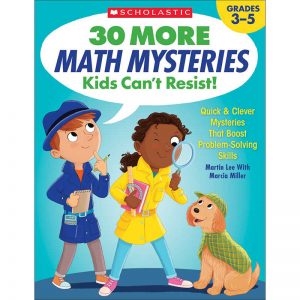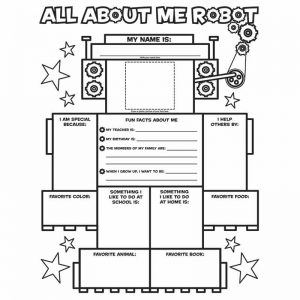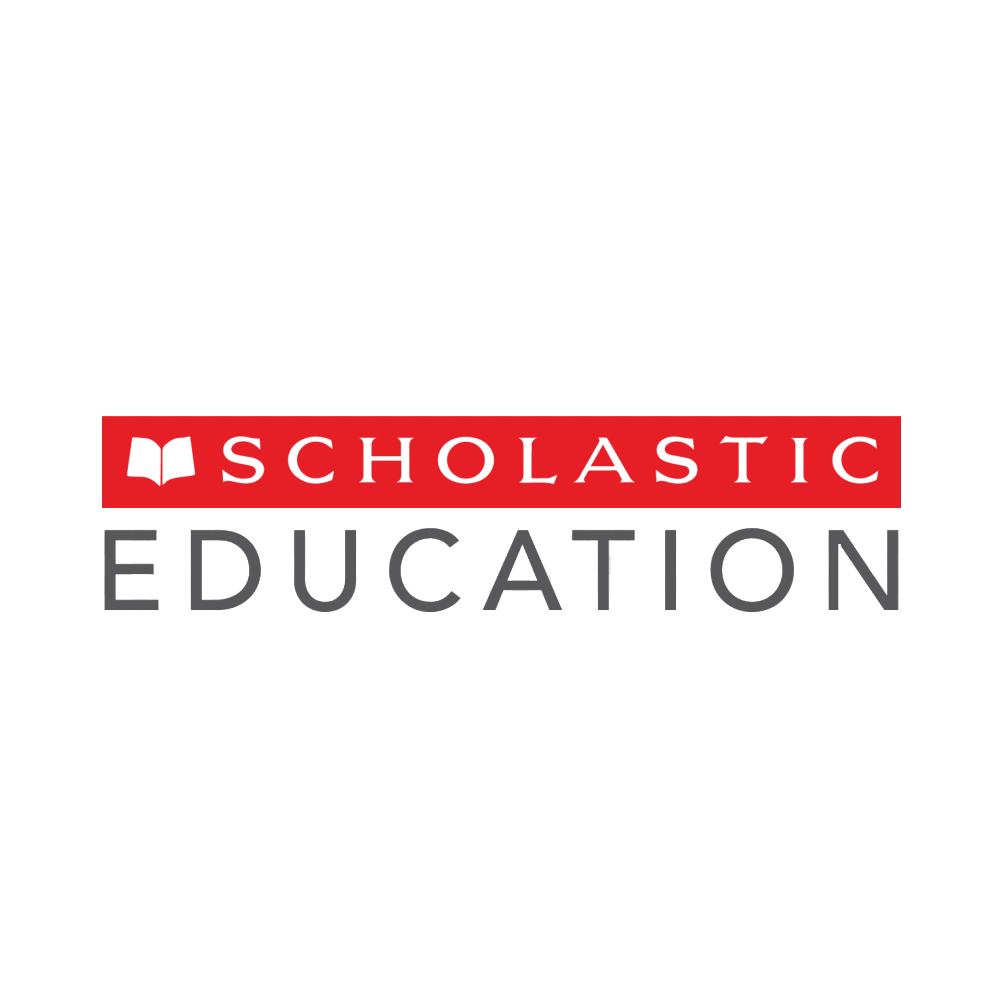Teaching Reading Strategies With Literature Introduction
Among students of all grade levels, middle schoolers are the ones most keenly experiencing the angst of sudden, often explosive, growth. In an increasingly complex world, these “hormones on feet,” as they have been wryly called, sometimes grapple with problems that confound even adults. We have learned through our combined years of teaching and raising young adolescents that they are understandably reluctant to discuss personal tribulations in large group settings. However, when motivated, they will animatedly sound off on issues involving third parties. Quality literature offers middle schoolers a way to safely step outside themselves long enough to gain a little perspective on life’s challenges. Reading about others’ misfortunes and missteps, as well as victories, and reflecting on them in meaningful ways encourages reason and resilience at a time when a strong sense of self is often still developing. Effectively teaching middle school students requires using instructional practices tailored to their unique stage of development, which honors one of the 14 characteristics that the National Middle School Association (2003) considers essential to a developmentally responsive middle school. The lessons contained in this book also address other characteristics, such as creating a “challenging and integrative” curriculum (NMSA, p. 7).
WORKSHEET & Sample PDF Activity
Sample PDF Activity
The variety of suggested books provides various points of entry into adolescent-friendly topics. Further, “multiple learning and teaching approaches” (NMSA, p. 7) are nurtured through the diverse suggestions for exploring each of the texts. We believe the following are key ingredients for motivating and enhancing learning in middle school:
• Students need to feel connected to the academic material they are studying, and it is our job as teachers to forge that connection (Guthrie, 2004; Smith & Wilhelm, 2006).
• They learn best when the material matters and makes sense to them. Integrating content across subject areas (when possible) mimics real-life learning, lending authenticity and reinforcing important concepts from each discipline (Goodman, 1986; NMSA, 2003).
• Students need guidance at all phases of the reading process: before, during, and after (Duke & Pearson, 2002; Vacca & Vacca, 2005).
• Wisely selected and well-implemented instructional strategies, especially writing ones, support both reading and cognitive growth (Alvermann & Phelps, 2005; Atwell, 1998; Calkins, 1994; Duke & Pearson, 2002; Irwin, 1998; Vacca & Vacca, 2005).
• Students need and deserve a variety of reading materials written at different levels, as well as some choice in how they demonstrate understanding of those materials (Allington, 2002; Gunning, 2003; Tomlinson, 2003).
• There is no more important time than the middle years to provide instruction that helps students develop empathy, cultural sensitivity, and healthy values (NMSA, 2003; Trelease, 2001; Wormeli, 2003).
• Middle schoolers require social interaction, not just at lunch or recess, but in the classroom as well (Hidi & Harackiewicz, 2000; NMSA, 2003; Vygotsky, 1962, 1978; Wilhelm & Smith, 2006).
Recent research studies on factors that motivate adolescent literacy have produced consistent results: To be engaged, students must
• Connect personally to the material
• Feel competent and be given some choice
• Have teachers who help them develop the skills and strategies they need
• See reading and writing as integral to addressing a real problem or contributing to an authentic ongoing conversation
• Participate in meaningful contexts for learning
(Guthrie, 2004; Wilhelm & Smith, 2006)
In the following two sections, co-author Nancy Fordham recalls planning a unit on Romeo and Juliet for an all-male ninth-grade English class some years ago and then reflects on the process, paving the way for the approach offered in this book.
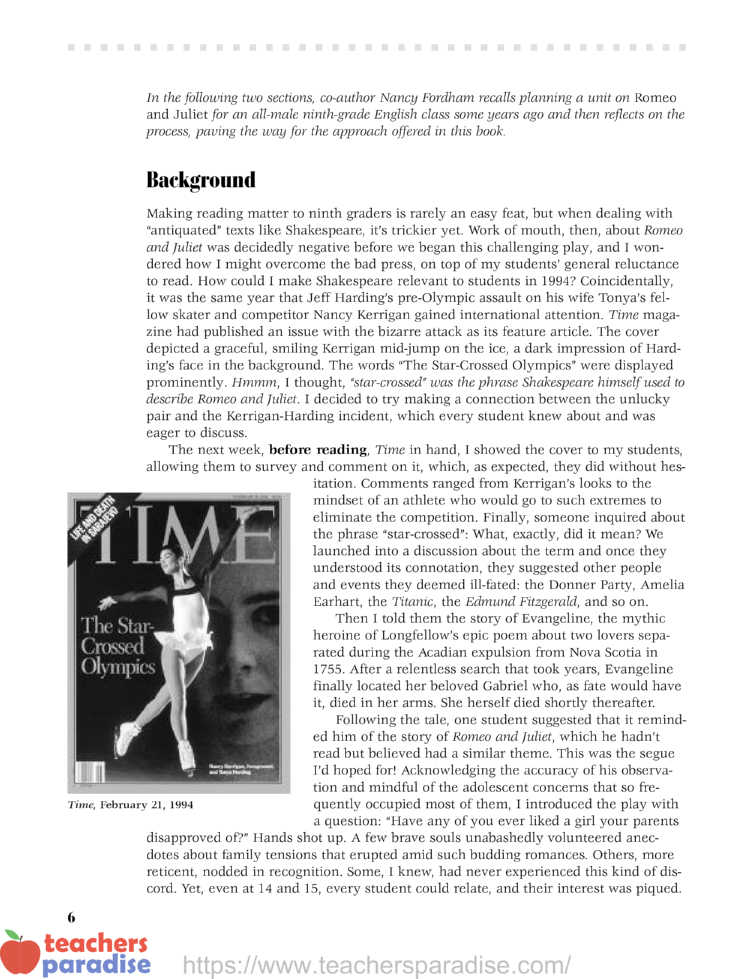
Background
Making reading matter to ninth graders is rarely an easy feat, but when dealing with “antiquated” texts like Shakespeare, it’s trickier yet. Work of mouth, then, about Romeo and Juliet was decidedly negative before we began this challenging play, and I wondered how I might overcome the bad press, on top of my students’ general reluctance to read. How could I make Shakespeare relevant to students in 1994? Coincidentally, it was the same year that Jeff Harding’s pre-Olympic assault on his wife Tonya’s fellow skater and competitor Nancy Kerrigan gained international attention. Time magazine had published an issue with the bizarre attack as its feature article. The cover depicted a graceful, smiling Kerrigan mid-jump on the ice, a dark impression of Harding’s face in the background. The words “The Star-Crossed Olympics” were displayed prominently. Hmmm, I thought, “star-crossed” was the phrase Shakespeare himself used to describe Romeo and Juliet. I decided to try making a connection between the unlucky pair and the Kerrigan-Harding incident, which every student knew about and was eager to discuss.
The next week, before reading, Time in hand, I showed the cover to my students, allowing them to survey and comment on it, which, as expected, they did without hesitation. Comments ranged from Kerrigan’s looks to the mindset of an athlete who would go to such extremes to eliminate the competition. Finally, someone inquired about the phrase “star-crossed”: What, exactly, did it mean? We launched into a discussion about the term and once they understood its connotation, they suggested other people and events they deemed ill-fated: the Donner Party, Amelia Earhart, the Titanic, the Edmund Fitzgerald, and so on.
Then I told them the story of Evangeline, the mythic heroine of Longfellow’s epic poem about two lovers separated during the Acadian expulsion from Nova Scotia in 1755. After a relentless search that took years, Evangeline finally located her beloved Gabriel who, as fate would have it, died in her arms. She herself died shortly thereafter.
Following the tale, one student suggested that it reminded him of the story of Romeo and Juliet, which he hadn’t read but believed had a similar theme. This was the segue I’d hoped for! Acknowledging the accuracy of his observation and mindful of the adolescent concerns that so frequently occupied most of them, I introduced the play with a question: “Have any of you ever liked a girl your parents disapproved of?” Hands shot up. A few brave souls unabashedly volunteered anecdotes about family tensions that erupted amid such budding romances. Others, more reticent, nodded in recognition. Some, I knew, had never experienced this kind of discord. Yet, even at 14 and 15, every student could relate, and their interest was piqued.
Once they felt some connection to the characters, I was able to generate more anticipation by keying in on other story elements intriguing to adolescents—family feuds and romantic rivals, for instance. What typically happens when two families are feuding and two males are competing for the same woman? Why, fights, of course! And so it went. Without giving away the story, I helped my students see links between their own lives and those of the characters in the play. Doing all this required a significant chunk of my 50-minute English period. I could have lamented the “lost teaching time,” but, I was convinced that the effort I’d devoted to helping students prepare for reading the play was time well spent. They were engaged and curious.
During reading, Shakespeare’s Elizabethan English was a barrier, so I chose to use an audio recording as students followed along in their books. We stopped regularly to discuss the characters and plot, and we occasionally dramatized key scenes.
After reading, I gave students a choice of responses that would demonstrate their understanding of the play, none of which involved a test. Some students sketched or sculpted renderings of important scenes and wrote about their significance. Others elected to rewrite scenes in contemporary English and re-enact them. Still others chose a more traditional form of response: an essay focusing on prescribed aspects of Romeo and Juliet.
Reflection
All in all, I was pleased with my students’ engagement with the play and their willingness to tolerate the difficult language. I believe they learned a great deal and even enjoyed it at times. However, hindsight and a growing understanding of the reading process tell me there was still more I could have done. While I would give myself high marks for building their background knowledge, helping them make connections, predict, and visualize plot elements, and for differentiating the assessments by allowing them a choice of authentic, performance-based tasks, I did not offer enough support during reading. Sure, we used a dramatic recording and discussed the play, which certainly helped. But I could have supported my struggling readers (and I had several) even more. I could have secured and encouraged the use of versions written in contemporary English. I could have read aloud portions of the play, modeling how I predicted, made connections with the story, drew inferences, and summarized. I could have used anticipation guides before students read certain scenes, or graphic organizers that would have helped them clarify character and plot elements. And I could have orchestrated purposeful small-group activities that encouraged both social interaction and learning.
I know better now. Though I currently teach university students, I still interact with middle school students and their teachers. No matter what the content, I encourage teachers to carefully prepare students for reading by building interest, motivation, and background knowledge. And I prod them to give students as many choices as possible for demonstrating their understanding of important concepts. I also encourage teachers to be much more attentive to the during-reading phase of comprehension, not leaving students on their own to struggle with the challenges many texts present.
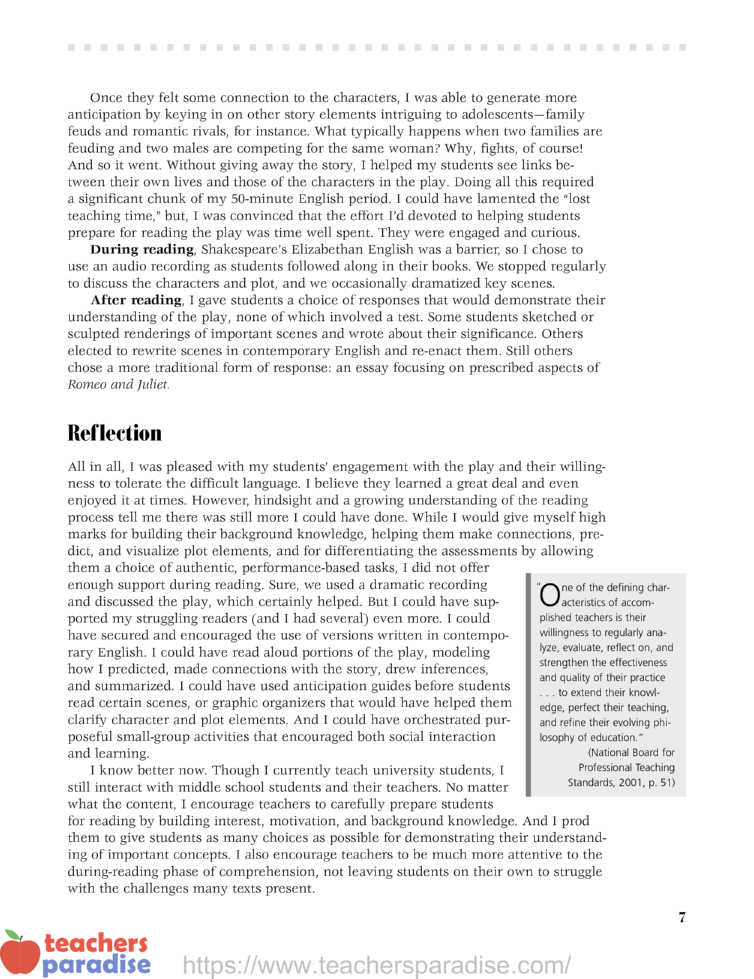
We teachers, whatever our subject areas, need to scaffold students’ comprehension as they read. That can best be done by showing students how we make sense of texts as we read, as well as by using a repertoire of proven instructional strategies that promote comprehension.
“One of the defining characteristics of accomplished teachers is their willingness to regularly analyze, evaluate, reflect on, and strengthen the effectiveness and quality of their practice . . . to extend their knowledge, perfect their teaching, and refine their evolving philosophy of education.”
(National Board for Professional Teaching Standards, 2001, p. 51)
About This Book
Reading comprehension strategies are embedded in each chapter, with every selection. In many cases, we’ve provided explicit instructions for modeling a particular reading strategy. The reproducibles accompanying many of these strategies will help you implement them.
We have selected literature for this book that correlates with themes appropriate for middle school and commonly found in the language arts/social studies curriculum: forging one’s identity; friendship; making choices; taking action; immigration; and the pioneering spirit. Moreover, the literature spans a variety of genres and reading levels—a must for developing students’ comprehension skills. You may choose to focus on just one book in each chapter, or on several. Another option is to use several theme-related books for reading in literature circles. There is so much wonderful literature on the market today that can be used to enliven content in every discipline. High-quality trade books, whether fiction or nonfiction, are interesting, informative, and written at a variety of reading levels. Even poetry and picture books are appropriate. Many of them teach concepts similar to those in textbooks, which are often intimidating to students.
The picture book format is . . . an elastic one, that has, particularly recently, been adapted for students of all ages and in various ways. Picture books encompass a wide range of subject matter. They can be used to enhance instruction in every content area . . . scaffold student understanding of a range of topics through formats that intrigue rather than intimidate . . . [and] can be a particularly rich resource for struggling readers and English language learners.” (Vacca & Vacca, 2005, pp.169–170)
We’ve also crafted this book with a teacher’s time in mind. You will notice as you thumb through its pages that the lessons supporting each of the 30 books adhere to our belief in the importance of the three-part instructional framework: before-, during-, and after-reading strategies (Vacca & Vacca, 2005). You may wonder how lessons this comprehensive could possibly save you time. Well, here’s the secret: integration. When you integrate interdisciplinary content with reading strategies, you actually free up valuable time. You are able to address important content standards and curricular topics while teaching essential skills.
We have taken a thematic approach to instruction, integrating two primary content areas: reading/language arts and social studies. For your convenience, we’ve identified under each book description the IRA/NCTE standards it addresses. In 1996, the International Reading Association and the National Council of Teachers of English published a joint set of Standards for the English Language Arts. While written as a set of 12 statements, they are intertwined—and not meant to be taught or learned separately. All are addressed within the choice of texts and variety of activities found in this book. In addition, we have included the Social Studies curriculum standards articulated in Expectations of Excellence (National Council for the Social Studies, 1994) that apply to each lesson. You will find both sets of standards in the Appendix, on pages 141 and 142. The lessons are designed with current research about learning in mind. Activating and building background knowledge is a crucial first step that engenders intellectual engagement and emotional connection. Without these, students won’t care about what you’re trying to teach. That’s why, in this book, you’ll see considerable effort expended on before-reading strategies. While you may opt to omit some of the activities for each selected reading, try to complete at least one as a way to engage students.
“Big picture” concepts are the focus of both the during- and after-reading strategies. Ironically, the during-reading component of the reading process, where most students stumble, typically receives the least focused attention from teachers. Though simple written pieces require minimal teacher support and guidance, texts that challenge readers with complex ideas and vocabulary—or pieces in which you suspect students may miss some of the subtleties—mandate more teacher support while students read. Assigning a chapter or section for homework, followed by the traditional question/discussion format, is not always sufficient—nor motivating. (Note: Make it a point to observe how many students are actually engaged during these discussions!) Therefore, in this book, extended lists of questions are not suggested. Our hope is that students come to appreciate the “whole” of literature, the reason “real” readers, not “school-time readers,” read text.
Allotting time to engage in after-reading strategies helps students debrief and refine their understanding of key concepts. Encourage students to question, consider, discuss, write, illustrate, dramatize, or otherwise expand on ideas gleaned through reading. Their content knowledge and literacy skills are then enhanced—a boon to students’ intellectual and academic growth.
While the activities recommended in this book are text specific, the strategies can be adapted across texts. The most adaptable of reading
strategies are activating background knowledge, predicting, and previewing, and we consistently recommend that you encourage students to use these.
From an instructional standpoint, reading aloud a particular chapter or part of a chapter typically enhances students’ enjoyment and understanding.
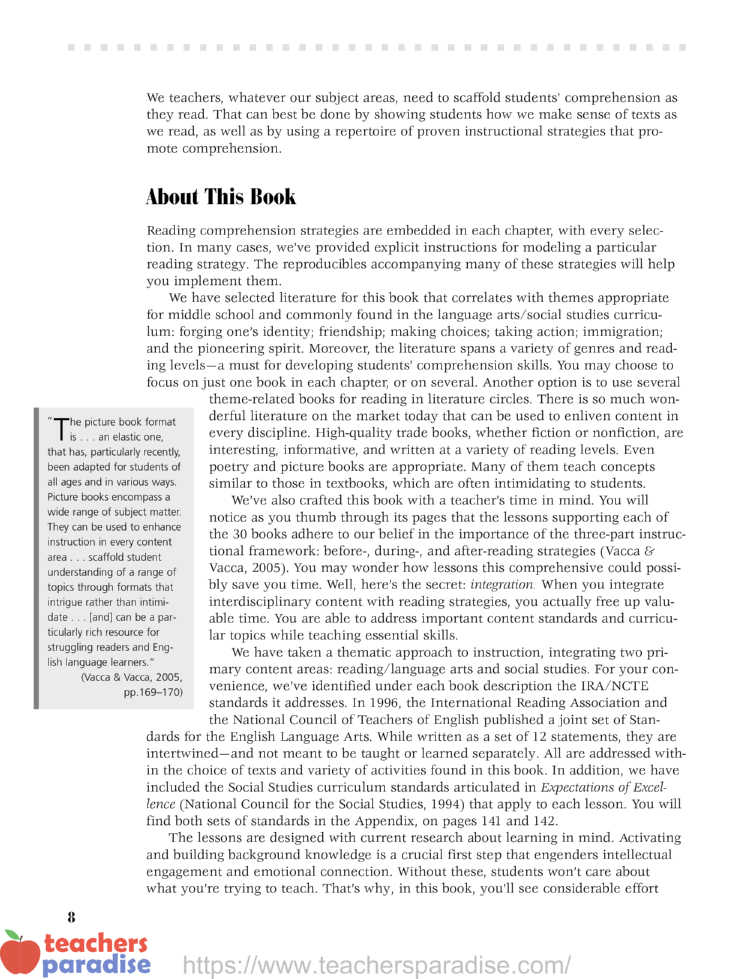
If engagement with a required text or topic seems unlikely, an anticipation guide may be just the way to pull students into the ideas. You may also find that having students complete a K-W-L grid or stimulating interest with photos or realia may work just as well.
If summarizing is the goal, a story pyramid might help students create a competent final project as they play with words in order to fill out the organizer. You may also choose to try a discussion web.
If extending students’ understandings is the goal, an I-chart may be a perfect research tool, or perhaps a compare/contrast chart or a writing frame.
While we have organized the strategies around a “before, during, and after” structure, these labels are not meant to be constrictive. You are the one who best knows your students and materials, and are the best-suited to determine the timing of the strategies and the emphasis placed on each.
We don’t recommend excessive disruption of students’ reading—sometimes it’s best to just let them go—however, wise teachers know when and how to increase instructional support during reading. Teacher modeling and the judicious use of a variety of instructional strategies help students see how proficient readers interact with text and assist them in extracting and organizing key ideas. Such strategies also increase the odds that students will be able to critically reflect on the information after reading.
Closing Thoughts
A key feature you’ll notice as you use these lessons is that they incorporate a good bit of social learning—purposeful, but definitely social—where students must confer with one another to gather ideas and hear other perspectives. Middle schoolers need social interaction, and they can and do learn efficiently when it is properly structured. It takes time to teach students the social skills and work habits needed for group tasks. However, these are essential life skills, and you may be amazed at the levels of thinking students demonstrate in such contexts.
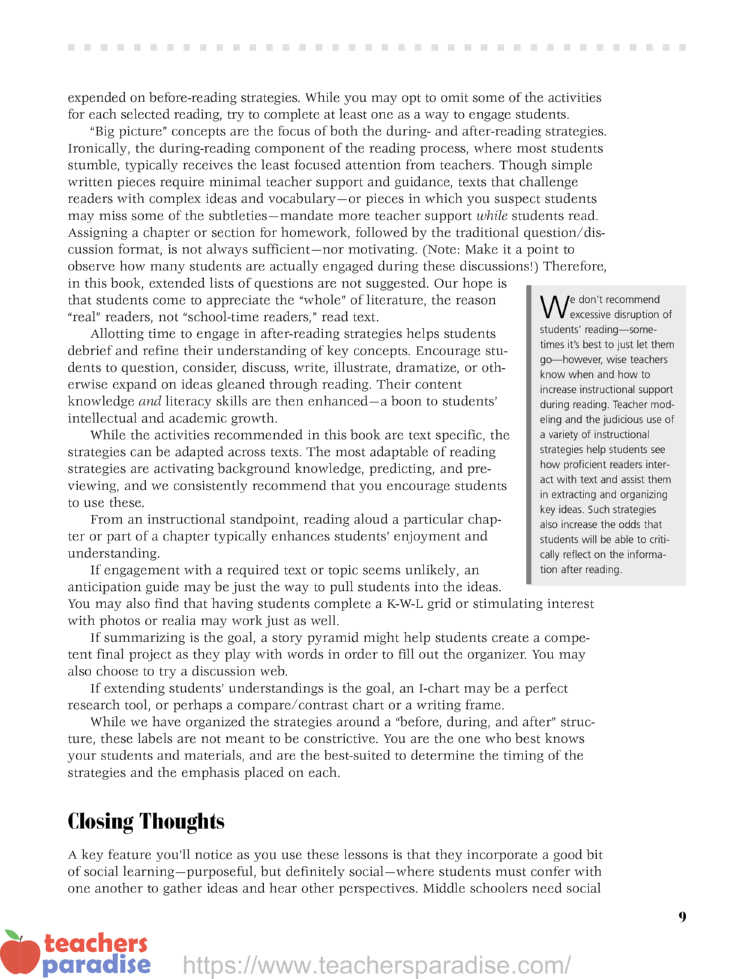
Like Kasten, Kristo, and McClure (2005), we believe in the power of literature to transform our students’ lives. Many of the books in this text will touch students in ways that textbooks alone can never do. What an opportunity they present to discuss values and healthy, ethical decision-making! So, go ahead—try some of the literature and lessons that follow. We think you’ll smile with satisfaction as you see your students enjoying literature, improving their literacy skills, expanding their content knowledge, and developing social understanding. While you are busy engaging your students’ minds with these lessons, you will also be engaging something else that drives learning: their hearts.
Since adolescents learn best through engagement and interaction, learning strategies [should] involve students in dialogue with teachers and one another.” (NMSA, 2003, p. 25)

